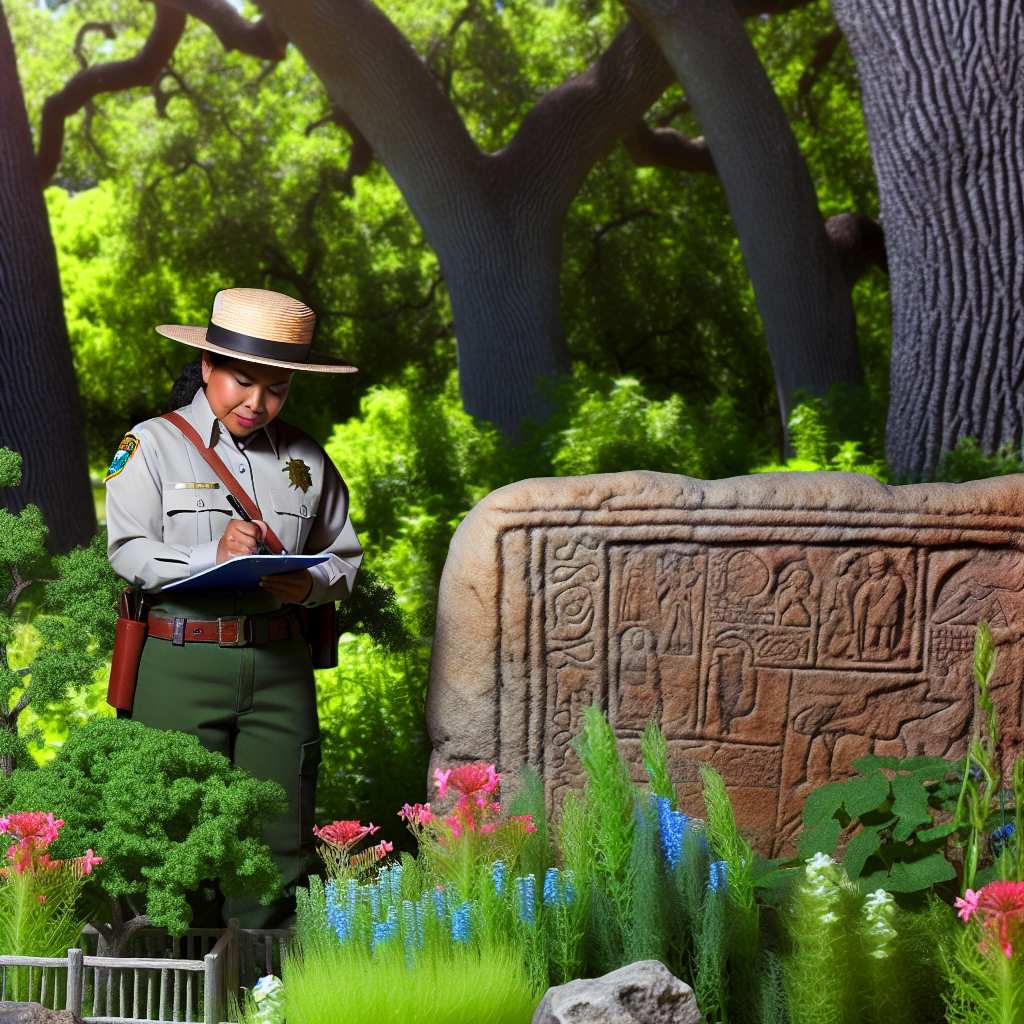Importance of Park Rangers
Park rangers play a crucial role in protecting and preserving natural and cultural resources within our national parks.
These dedicated individuals serve as stewards of our nation’s most cherished landscapes.
Preserving Historic Sites
Preserving historic sites is essential to maintaining our connection to the past.
It ensures that future generations can learn from and appreciate our shared history.
These sites serve as windows into the past.
They allow us to better understand our roots and heritage.
Role of Park Rangers in Preservation
When it comes to historic sites, park rangers take on a special responsibility.
They work tirelessly to safeguard these locations.
This ensures that they remain intact and accessible for visitors to explore and learn from.
By protecting these sites, park rangers help to conserve our cultural heritage for years to come.
Park rangers are often tasked with monitoring the condition of historic sites.
They implement conservation efforts and educate the public on the importance of preserving these locations.
They may also work with archaeologists, historians, and other experts.
Together, they develop conservation plans and ensure that these sites are properly maintained.
Public Engagement and Education
In addition to their preservation duties, park rangers also play a vital role in interpreting the history of these sites for visitors.
They lead guided tours and provide educational programs.
Park rangers offer insights into the significance of the locations they protect.
By sharing their knowledge and passion for history, park rangers foster a deeper appreciation for our collective past.
Through their dedication and expertise, park rangers help to ensure that these precious locations are protected.
Their stories continue to be told for generations to come.
Transform Your Career Today
Unlock a personalized career strategy that drives real results. Get tailored advice and a roadmap designed just for you.
Start NowOverview of Historic Sites
Historic sites are places that hold significant importance due to their past events or cultural significance.
Preserving historic sites is essential for maintaining our cultural heritage and passing down stories to future generations.
- The Great Wall of China: A marvel of ancient engineering that stretches over 13,000 miles.
- The Pyramids of Giza: Iconic structures that have stood for over 4,500 years in Egypt.
- Machu Picchu: A mysterious Incan city perched high in the Andes mountains of Peru.
What Constitutes a Historic Site?
Historic sites can include buildings, monuments, landscapes, or even whole cities that have historical significance.
These sites are often preserved due to their cultural, architectural, or archaeological value.
Significance of Preserving Historic Sites
Preserving historic sites allows us to connect with our past and understand the roots of our culture.
It helps us appreciate the achievements of previous civilizations and learn from their mistakes.
Examples of Famous Historic Sites Around the World
The Taj Mahal: An iconic symbol of love located in India, known for its intricate architecture.
The Colosseum: A grand amphitheater in Rome, Italy, where gladiatorial contests were held.
- The Acropolis: A citadel perched on a rocky outcrop above Athens, Greece, with ancient ruins.
- The Statue of Liberty: A symbol of freedom located in New York Harbor, a gift from France.
- Stonehenge: A mysterious prehistoric monument in England consisting of standing stones.
These sites capture the essence of different civilizations and eras, offering valuable insights into our shared human history.
Responsibilities of a Park Ranger
Park rangers patrol designated areas to ensure safety.
They protect wildlife and the natural environment.
Enforcement of park rules maintains order among visitors.
Assisting visitors with information is a key duty.
They provide directions and emergency aid as needed.
Conducting educational programs raises conservation awareness.
Park rangers participate in search and rescue missions.
These missions help those lost while hiking or camping.
Detail the Various Duties of a Park Ranger
Park rangers have a wide range of responsibilities.
These are essential for managing and preserving historic sites.
They patrol areas to protect the natural habitat and wildlife.
Transform Your Career Today
Unlock a personalized career strategy that drives real results. Get tailored advice and a roadmap designed just for you.
Start NowEnforcing regulations prevents unauthorized activities.
This is crucial to maintaining environmental integrity.
Park rangers educate visitors about conservation importance.
They conduct educational programs and interpretive tours.
Highlight How Park Rangers Play a Crucial Role in Conservation Efforts
Park rangers lead conservation efforts effectively.
They work tirelessly to preserve natural beauty.
Wildlife populations are monitored for health and stability.
Regulations help minimize human impacts on ecosystems.
Participation in habitat restoration projects is vital.
This promotes biodiversity and protects endangered species.
Through their dedication, rangers significantly contribute to conservation.
Emphasize the Importance of Education and Awareness in Their Work
Education and awareness are integral to a park ranger’s role.
Engaging visitors fosters stewardship for the environment.
Park rangers provide significant information for understanding heritage.
Interpretive programs inspire appreciation for historical significance.
They raise awareness about important conservation issues.
Encouraging sustainable behavior empowers visitors to take action.
This protects and preserves valuable resources for future generations.
Discover More: Emergency Management Director: Community Preparedness Programs
Preservation Techniques
Park rangers play a crucial role in preserving historic sites through a variety of methods and techniques.
Transform Your Career Today
Unlock a personalized career strategy that drives real results. Get tailored advice and a roadmap designed just for you.
Start NowThese methods are essential in safeguarding these significant locations for future generations to appreciate and learn from.
Documentation
One of the primary preservation techniques employed by park rangers is meticulous documentation of the site.
This includes recording the history, architecture, and cultural significance of the location.
By documenting these details, park rangers can better understand the site’s importance and create a plan for its preservation.
Monitoring
Park rangers regularly monitor the condition of historic sites to identify any potential threats or areas of concern.
By conducting regular inspections, rangers can address issues such as erosion, vandalism, or natural disasters that may compromise the site’s integrity.
Through careful monitoring, park rangers can take proactive measures to protect the historic site from harm.
Conservation
To preserve historic sites, park rangers engage in conservation efforts to maintain the site’s original features and materials.
This may involve repairing or replacing deteriorating elements, such as structural components or artifacts.
By practicing conservation techniques, park rangers ensure that the site retains its historical authenticity and significance.
Education and Outreach
Park rangers play a vital role in educating the public about the importance of historic preservation.
Through guided tours, educational programs, and outreach initiatives, rangers help raise awareness about the significance of these sites and their role in shaping our cultural heritage.
By promoting understanding and appreciation, park rangers inspire others to join in the preservation efforts.
Challenges in Preserving Historic Sites
Despite the best efforts of park rangers, preserving historic sites comes with its own set of challenges.
These challenges can range from natural disasters to human activities that threaten the site’s integrity and longevity.
Environmental Factors
Natural disasters such as floods, fires, earthquakes, and severe weather events pose a significant threat to historic sites.
These events can cause irreparable damage to the structures and artifacts, making preservation efforts challenging.
Park rangers must be prepared to respond swiftly and effectively to mitigate the impact of environmental factors on these sites.
Human Impact
Human activities, such as vandalism, theft, and development, also pose a threat to historic sites.
These actions can lead to the destruction or loss of valuable artifacts and structures, jeopardizing the site’s cultural significance.
Transform Your Career Today
Unlock a personalized career strategy that drives real results. Get tailored advice and a roadmap designed just for you.
Start NowPark rangers must work diligently to protect these sites from unauthorized access and activities that could harm them.
Funding and Resources
Preserving historic sites requires significant funding and resources to carry out conservation efforts effectively.
Limited budgets and resources can hinder the maintenance and protection of these sites, making it challenging for park rangers to address all preservation needs adequately.
Securing adequate funding and resources is essential to ensure the long-term preservation of historic sites.
Successful Preservation Efforts Led by Park Rangers
Despite the challenges they face, park rangers have achieved remarkable success in preserving historic sites through their dedication and expertise.
Several examples demonstrate the effective preservation efforts led by park rangers.
Mesa Verde National Park
Located in Colorado, Mesa Verde National Park is a UNESCO World Heritage Site known for its well-preserved cliff dwellings built by the Ancestral Puebloans.
Park rangers at Mesa Verde have successfully implemented conservation programs to protect and maintain these ancient structures, ensuring their longevity for future generations.
Gettysburg National Military Park
Gettysburg National Military Park in Pennsylvania is another example of successful preservation efforts led by park rangers.
The park rangers have worked tirelessly to restore and conserve the historic battlefield and monuments, preserving the site’s significance as a pivotal moment in American history.
Colonial Williamsburg
Colonial Williamsburg in Virginia is a living history museum that showcases life in 18th-century America.
Park rangers at Colonial Williamsburg engage visitors through interactive programs and demonstrations, bringing history to life and preserving the site’s cultural heritage for future generations.
Gain More Insights: Cybersecurity Specialist: Ethical Considerations in the Job
Collaboration with Experts
Park rangers often work closely with historians, archaeologists, and other experts in preserving historic sites.
- Historians provide valuable insights into the historical significance of the site.
- Archaeologists help uncover artifacts and interpret the site’s history through excavation.
- Experts in conservation offer guidance on preserving and maintaining the site’s integrity.
The interdisciplinary collaboration between park rangers and experts is crucial for successful preservation efforts.
By combining their expertise, these professionals can develop comprehensive preservation strategies.
Rangers benefit from the in-depth knowledge and specialized skills that experts bring to the table.
Working together, they ensure that historic sites are protected for future generations to enjoy.
Successful collaborations between park rangers and experts have been instrumental in preserving iconic sites.
- At Mesa Verde National Park, rangers collaborate with archaeologists to protect ancient cliff dwellings.
- In Gettysburg National Military Park, historians work with rangers to preserve Civil War battlefields.
- At Independence Hall in Philadelphia, conservationists assist rangers in maintaining the historic building.
These examples highlight the benefits of interdisciplinary collaboration in the field of historic site preservation.
Transform Your Career Today
Unlock a personalized career strategy that drives real results. Get tailored advice and a roadmap designed just for you.
Start NowDiscover More: CBP Officer’s Role in Natural Disaster Response

Community Engagement
Engaging local communities in preservation efforts is crucial for the long-term conservation of historic sites.
- Local Communities Involvement Importance
- Park Rangers Engagement with the Public
- Strategies for Fostering Community Support
Involving local communities creates a sense of ownership and pride in the historic sites.
Park rangers play a significant role in raising awareness about the importance of preserving historic sites.
Organizing community events, guided tours, and educational programs can help foster community support.
Encourage volunteer opportunities for community members to actively participate in preservation projects.
Collaborate with local schools to educate students about the historical significance of the sites.
By engaging with the local community, park rangers create a network of support that ensures the preservation of historic sites for future generations.
Gain More Insights: How to Pass the DEA Agent Written Exam
Technology and Innovation
When it comes to preserving historic sites, technology plays a crucial role.
Advancements in technology have revolutionized conservation practices in recent years.
This enables rangers to protect and maintain these important cultural landmarks more effectively.
Role of Technology in Preservation Efforts
Technology has become an essential tool for park rangers in their mission to safeguard historic sites.
From using drones to monitor and assess the condition of structures.
To employing GIS technology for mapping and tracking changes in the environment.
Rangers rely on innovative solutions to preserve these valuable cultural assets.
Advancements in Conservation Practices
The development of cutting-edge technology has transformed the way park rangers approach conservation.
With tools like LiDAR scanners, they can create detailed 3D models of landscapes and structures.
Rangers are better equipped to identify potential threats.
This enables them to implement proactive measures to protect historic sites from natural disasters and human interference.
Transform Your Career Today
Unlock a personalized career strategy that drives real results. Get tailored advice and a roadmap designed just for you.
Start NowInnovative Tools and Techniques
Park rangers utilize a variety of innovative tools and techniques to maintain historic sites.
Ground-penetrating radar uncovers hidden archaeological artifacts without disturbing the site.
Remote sensing technology allows rangers to detect changes in vegetation and soil composition.
These changes could indicate environmental degradation.
Additionally, thermal imaging cameras help identify structural issues that may not be visible to the naked eye.
This enables rangers to address maintenance needs promptly.
Park Rangers as Stewards of Historic Sites
Park rangers play a crucial role in preserving historic sites through their dedication to conservation efforts.
They monitor and protect these sites from potential threats, ensuring their longevity for future generations.
By educating visitors and enforcing regulations, park rangers help maintain the integrity of these significant locations.
It is important to recognize the value of park rangers in safeguarding our historical heritage, as they serve as stewards of the past.
Their passion for nature and history drives them to work tirelessly to protect these sites and ensure they remain intact for years to come.
As such, it is essential for us to appreciate and support the work of park rangers in their conservation efforts.
By showing our gratitude and involvement, we can help them continue their vital role in preserving the cultural and natural treasures of our world.
Let us all take a moment to acknowledge the dedication and commitment of park rangers in preserving historic sites for the benefit of all.
Additional Resources
Springfield Armory National Historic Site (U.S. National Park Service)
The Irreplaceable Value of National Park Service Staff · National …




